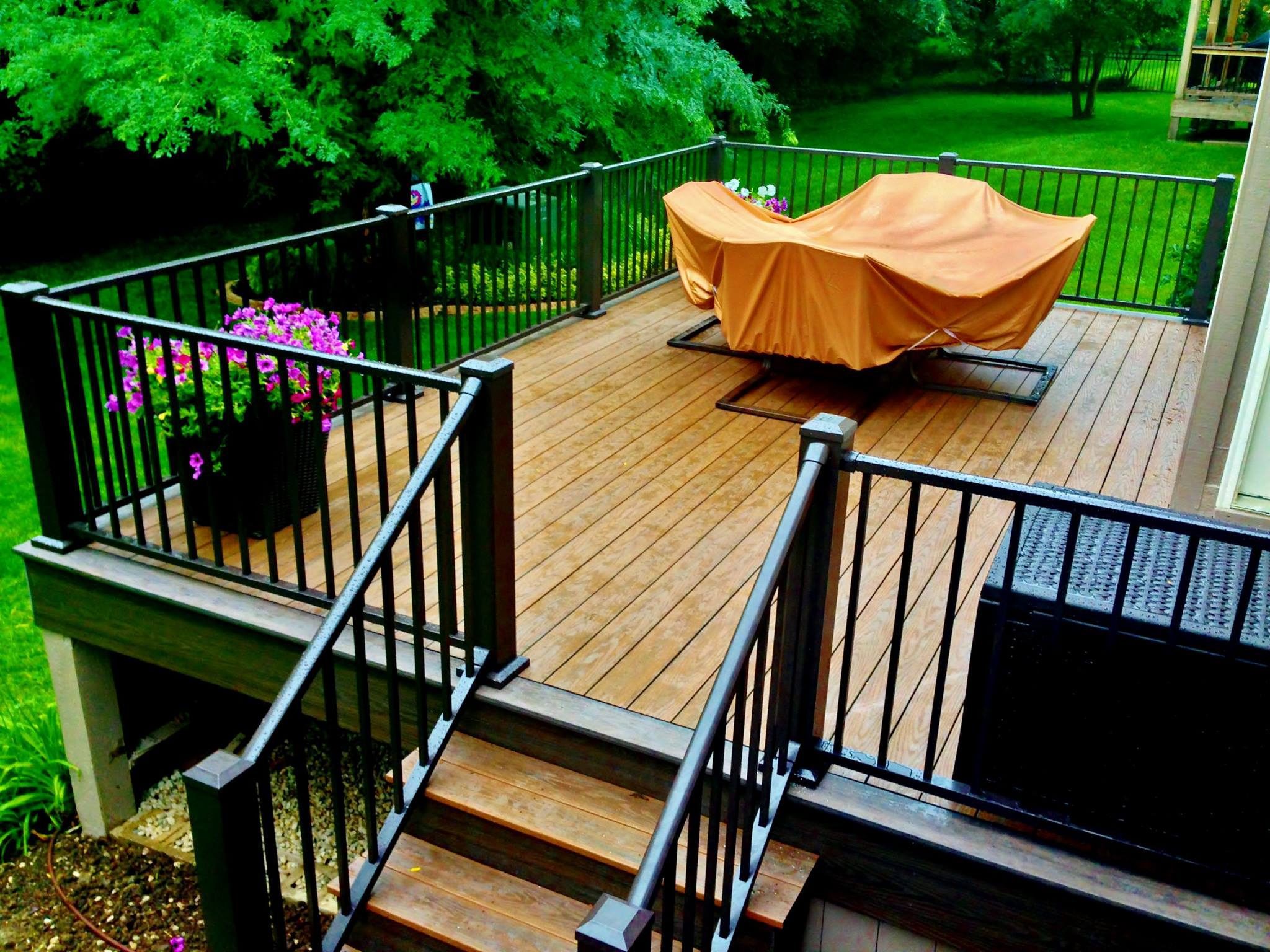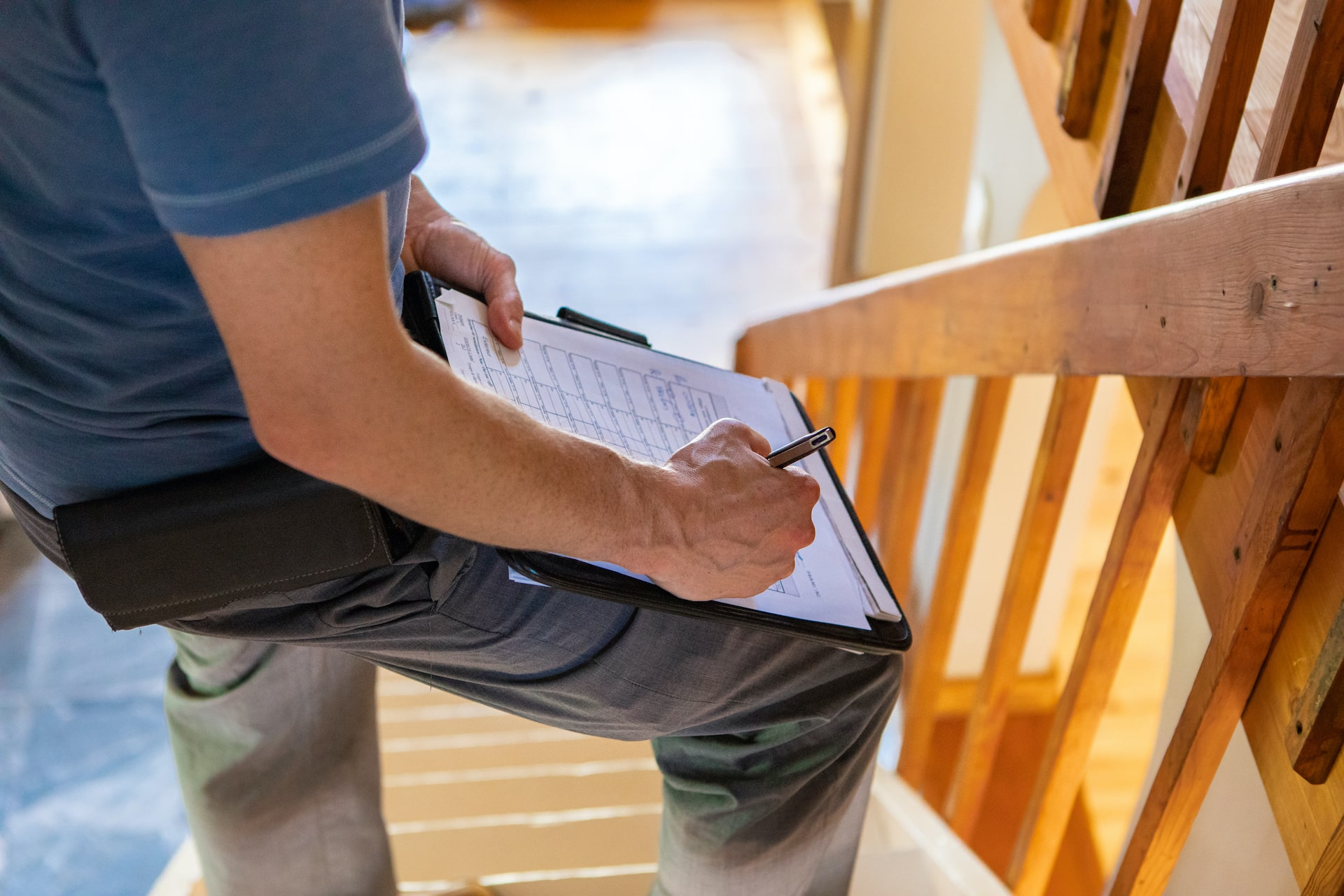Building a deck is fun and exciting. There are so many options you can choose. Once you’ve decided on the type of decking, you must choose the railing that will complement it. The best deck railing will make a statement and add aesthetic appeal. There are so many styles, colors, price points, and material options to choose from that it can become overwhelming. I like to approach deck railing selections based on three things: the style of the home, the view from the deck, and ROI (return on investment).
The Best Deck Railing Material Based on Cost
Cost is definitely a factor when it comes to choosing the best deck railing. To give you an idea of cost per type of railing, here is a list of railing types from lowest price to highest:
- Pressure-treated railing
- Metal/steel railing
- Cedar railing
- Aluminum railing
- Hog panel railing
- Composite railing
- Glass railing
- Cable railing
- Custom metal railing
Helpful Tips When Choosing Deck Railing:
Color is more important than you might realize.
Dark colors blend…light colors block. Keep in mind that dark colors like black, brown, and green disappear into the backdrop while lighter colors like white or almond will attract your eye’s attention and pop from the background. So if you have a beautiful view from the deck and you don’t want it disrupted, you would want to stay with a dark color. If you want to accent the house and create a space within the deck area itself, go with white or something similar. As crazy as it sounds, a white deck railing offers a lot of privacy because it’s extremely hard to see past it.
Composites can get hot and take more labor to install.
Aluminum does not retain as much heat as steel and composite plus it will never rust.
Steel will rust over time.
All paint, e-coating, and powder coatings will oxidize over time from UV exposure.
Best Places to Shop for Deck Railing in Kansas City
The best deck railing system should be an expression of your taste, style, and home’s architecture. The best showroom in Kansas City or Johnson County to see tons of great deck railing options is Kansas City Deck Supply. They stock a number of quality manufacturers and can special order just about any deck rail your heart desires. For those of you who want to go with a custom railing, give us a call. We work closely with custom metal handrail fabricators here in the Kansas City metro area and can do some pretty amazing things. If you want an old-world, wrought iron handrail to seamlessly run around your deck and down a spiral staircase, we can handle it.
Deck Railing Pros & Cons
The following sections break down each type of railing to help you decide which one might be right for your deck:
Pressure Treated Deck Railing

The most economical deck railing is pressure-treated pine. It has been installed and hundreds upon hundreds of spec. homes across the United States for many years. If you are a home builder or flipper trying to maximize margins on starter homes, pressure-treated deck railing is hard to beat. That being said, outside of being the least expensive, it is hard to find positive attributes about using treated lumber for deck railing. Due to the pressure treatment process, this board will shrink, twist, curl, cup, check, and splinter. You might even have to explain why you used it for deck railing before you are allowed through the gates of heaven and lose seven years of tax returns. 😉 It is not uncommon to get a call to replace pressure-treated handrails on homes less than five years old. However, if the budget is tight, it will work in a pinch. If you do decide to go with pressure-treated deck railing, it would be in your favor to source kiln-dried pressure treated and install it with good quality fasteners immediately upon arrival. Kiln drying decreases the amount of warping and twisting.
Metal or Steel Deck Railing

Metal deck railing is by far the most common deck railing in the Kansas City metro area at this time. You will see it everywhere from starter homes to million-dollar-plus home price points. Fortress Fe26 deck railing is the most popular model and comes in at a good price. Fortress Fe26 is basically the same price as cedar handrail with black metal balusters. However, it outperforms the cedar with metal balusters across the board.
The Fortress railing is very simple, low profile, with clean lines. When less is more, Fe26 is the solution. It is an all welded panel of galvanized E-coated steel. I like to use this in applications when I want to make the space feel as big as possible. Fortress Fe26 a great metal deck railing for decks with a view. That being said, all steel will rust over time, so be mindful of that going into it. On the average size deck, you can upgrade to aluminum for around $1,000 more. The bottom line is metal railings are a great choice and you enter the market with the Fortress Fe26.
Cedar Deck Railing

Cedar is an excellent choice for wood handrail. Since cedar is kiln dried, shrinking, twisting, warping, and cupping is minimal. You will still notice checking and splintering, but that should be expected with any wood left outside in the elements. One thing to be mindful of is that the handrail is the most labor intensive part of deck maintenance. One great solution to minimize the maintenance is to either install metal balusters or, even better, sections of aluminum or metal deck railing between the cedar posts. Oftentimes, we like to use a matching metal post cap on top of the post too! What this does is protect the top of the post from water and provides a very nice craftsman style railing system that is fairly low maintenance. This type of rail system looks exceptionally nice with capped composite decking.
 Aluminum Deck Railing
Aluminum Deck Railing
Aluminum deck railing is taking the market by storm and for good reason. With no worries about rust, and high heat dissipation it is no wonder people are willing to pay the premium. As a matter of fact, aluminum has one of highest thermal conductivity properties of all metals. There are a number of different manufacturers on the market serving up aluminum deck railing. Most offer a limited lifetime warranty. Bear in mind that all paint oxidizes from UV exposure and there are limitations regarding the paint.
Some of my favorite manufacturers of aluminum deck railing are:
- Fortress offers an all-welded panel that is very straightforward. I am a fan of a welded baluster because it is less noisy over time and it also offers good peace of mind with children. Kids love to stand in the bottom rung. With a welded baluster, you can rest easy knowing that there won’t be any balusters falling out.
- Westbury (pictured above) is made in the USA! For those of you who don’t know, it is hard to find anything metal being fabricated at mass volume in the U.S. So if you want to keep your money local, this is the manufacturer to do business with. The profile of this railing is a C-shaped top about two inches wide that fits very comfortably in your hand. The handrail is extruded with a plastic pressure plate inside the top and bottom horizontally. The trim on this railing system is really clean. The rail looks good with 2”, 4”, aluminum 6” and cedar 6” posts. Deck lighting can also be integrated into the post caps. Westbury deck railing offers multiple colors and styles. One of the things I like most about Westbury is it is semi-customizable. I am able to send them a radius and they will curve the railing to my specs in the factory. Talk about a good-looking deck!
- Deckpro offers a reasonably priced product and offers a traditional bread loaf profile top rail. This is an extruded deck railing system that has a decent plug-and-play deck light package.
 Hog-Panel Deck Railing
Hog-Panel Deck Railing
A hog-panel railing system consists of a cedar post, cedar top & bottom plate, and a hog panel. The hog panel is typically a galvanized heavy gauge wire panel with 4” x 4” square openings. It gives off a very contemporary craftsman architectural vibe. In the right setting, this handrail system is warm with clean lines. It reminds me of something I would see in Colorado. We don’t get a lot of requests for this deck railing in Kansas City, however, when we use it, the projects always exceed everyone’s expectations!
 Composite Deck Railing
Composite Deck Railing
Composite deck railing is a large profile handrail that can be very substantial looking. There are many manufacturers producing some good-looking composite deck railing systems. One I am most familiar with is AZEK. AZEK makes a traditional bread loaf profile. Most composite railing systems come with a composite sleeve that goes over a wood post. From my experience, the composite systems on the market are over-engineered, very expensive, and labor intensive to install seamlessly. However, if you don’t mind spending the extra money and time during installation, they can be absolutely beautiful. If you want the railing to be a focal point, this is a good way to go.
 Glass Deck Railing
Glass Deck Railing
If you are looking for a railing system that will not intrude on the vista, look no further. One misconception is that glass railing is high maintenance and requires excessive cleaning. This is simply not true. You will need to clean the glass no more than you clean the outside of your exterior home windows. Glass railing is classy and fits as seamlessly on a cabin at the lake as it does a contemporary home in the heart of Kansas City. There are multiple styles and manufacturers of glass deck railing. Westbury and Fortress both offer a reasonable rail system. If you are looking for a more commercial feel, using pucks, we can do that too.
Cable Deck Railing

Cable railing comes in both vertical and horizontal systems. If you have children and you are in the market for a cable railing, you might want to consider going with vertical deck railing. This prevents children from climbing it like a ladder. Other benefits of vertical rails are that it’s typically more economical and has less thermal expansion and contraction. I love the look of the horizontal rail systems but I dread the maintenance of tightening and loosening the cables to prevent sag in the summer and pulling posts out of plumb in the winter. That being said, it’s very elegant and offers the cleanest lines. Keep in mind that the cable is stainless steel and even though it’s very small, it will attract your attention and doesn’t always disappear into the background like you think it might.
 Custom Metal Deck Railing
Custom Metal Deck Railing
Nothing screams Victorian, Georgian, Tudor, and 18th-century architecture like custom wrought-iron handrail. If you are looking to keep the integrity of old-world architecture, there is no substitute for custom metal railing. But this isn’t just for historians. When you go custom, it’s a blank canvas and any architectural theme can be obtained.



